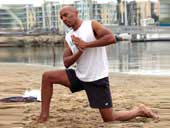Healthy Exercise
 In July 2011, the American College of Sports Medicine (ACSM) published their position statement and guidelines for what is considered to be a healthy exercise (as opposed to over exercise or compulsive exercise that might be assocated with anorexia athletica). The position paper, titled “Quantity and Quality of Exercise for Developing and Maintaining Cardiorespiratory, Musculoskeletal, and Neuromotor Fitness in Apparently Healthy Adults: Guidance for Prescribing Exercise” incorporates the most current scientific evidence available to date and was published in Medicine & Science in Sports & Exercise, the official journal of ACSM.
In July 2011, the American College of Sports Medicine (ACSM) published their position statement and guidelines for what is considered to be a healthy exercise (as opposed to over exercise or compulsive exercise that might be assocated with anorexia athletica). The position paper, titled “Quantity and Quality of Exercise for Developing and Maintaining Cardiorespiratory, Musculoskeletal, and Neuromotor Fitness in Apparently Healthy Adults: Guidance for Prescribing Exercise” incorporates the most current scientific evidence available to date and was published in Medicine & Science in Sports & Exercise, the official journal of ACSM.
Four Major Types of Healthy Exercise
Healthy exercise is classified into four major types: Cardiorespiratory, Flexibility, Resistance, and Neuromotor. The acceptable limits of all four exercise types are addressed in the recommendation
For Cardiorespiratory exercise, the type of activity we normal think of as “exercise” that increases the heart rate, increases the breathing rate, and causes a person to sweat, the ACSM recommends a minimum of 150 minutes of moderate intensity exercise per week. These 150 minutes can be either made up of either 30 to 60 minute sessions of moderate activity five times weekly or 20 to 60 minute sessions of vigorous activity three times weekly. In addition, the sessions can be completed as one continuous session, or as multiple shorter sessions. Gradual increases in the duration, frequency, and intensity of workouts is recommended but even those who cannot complete these cardiorespiratory exercise goals will still benefit from increased activity.
In terms of Flexibility exercise, the ACSM recommends a person engage in this type of healthy exercise two to three times weekly for 10 to 30 seconds at the point of tightness or discomfort to increase range of motion. Stretches should be completed two to four times and for a cumulative time of 60 seconds. Flexibility exercises are more effective once the muscles are warm so it is recommended that light activity or a hot steam be completed prior to stretching.
The ACSM recommends Resistance exercise also be completed two to three times weekly on all the major muscle groups. A person should rest 48 hours between exercise sessions. Two to four sets of 8 to 20 repetitions should be completed. A lower number of repetitions (from 8 to 12) increase strength and power while a higher number of repetitions (from 15 to 20) increase muscular endurance.
Neuromotor exercise, also called functionality exercise, emphasizes movements that require balance, agility, coordination, and gait. Rather than focusing on one muscle group, neuromotor exercises involve multiple muscles and require the activation of multiple nerve fibers. An example of this type of exercise is yoga or Tai Chi. These exercises should be engaged in two to three times weekly for 20 to 30 minutes.
These recommendations are intended for an apparently healthy adult. They would be different for older or younger populations or those with special health conditions. The ACSM statement is primarily geared toward the sedentary population and emphasizes getting enough proper healthy exercise to maintain health and fitness.
photo by John Nyboer